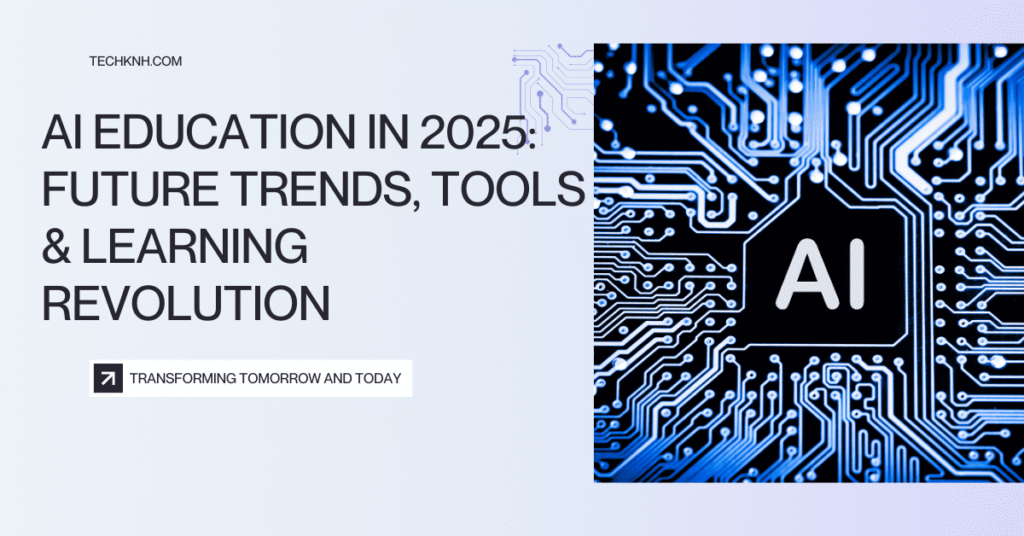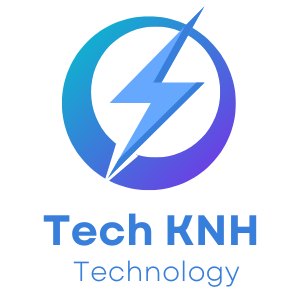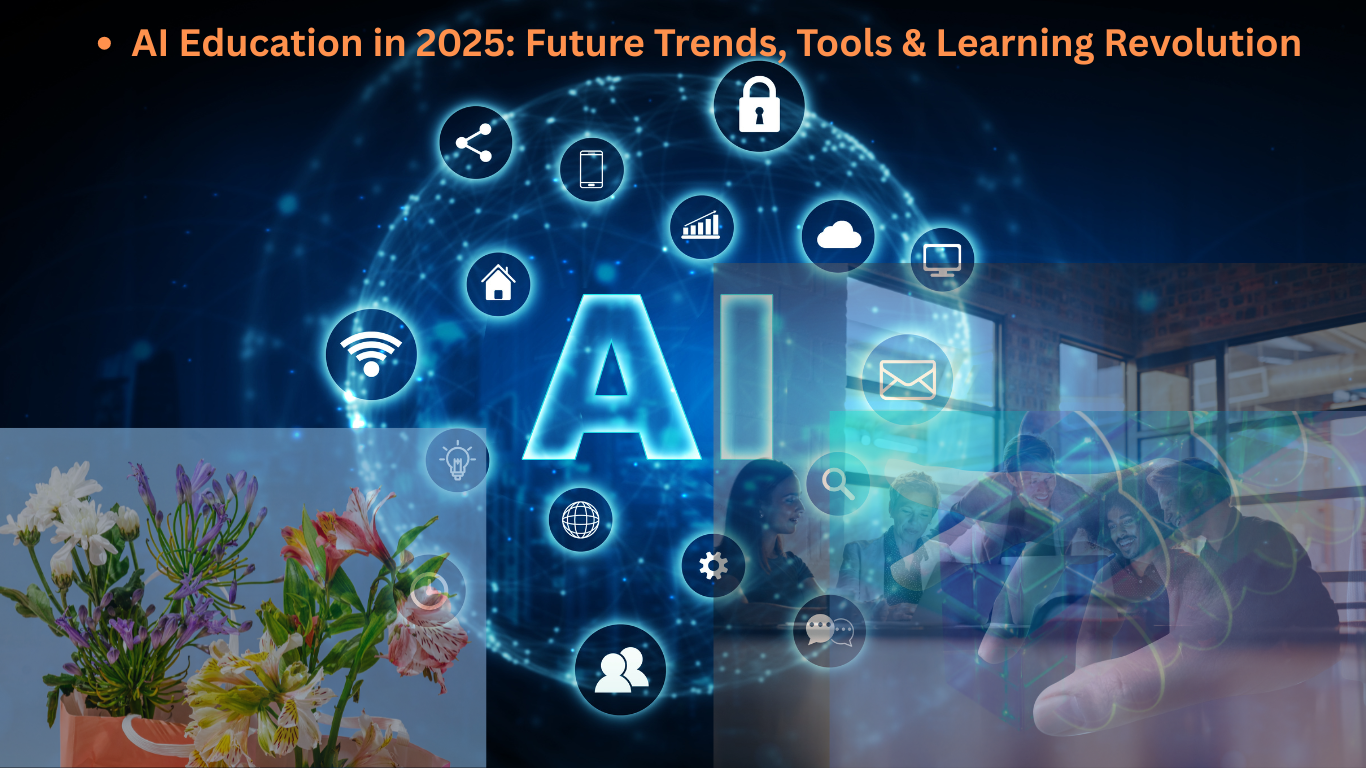“AI will be the biggest driver of transformation for education in the next decade.” – Forbes, 2024
AI Education & Learning
- Beginner’s Guide to Artificial Intelligence (2025 Edition)
- Best Online Courses to Learn AI for Free
- AI vs ML vs Deep Learning: What’s the Difference?
- AI Terms Explained in Simple Language
- Top 5 Books to Understand AI Without Coding
🔥 Introduction: The AI Revolution Is Reshaping How We Learn
AI Education in 2025: Exciting Trends, Powerful Tools & Smarter Learning
Imagine a world where personalized education is not a luxury but a standard. A world where AI-powered tutors adapt to every learner’s pace, and up skilling is available 24/7 through virtual AI mentors. Welcome to AI in 2025—where the fusion of artificial intelligence and education is transforming the way we learn, teach, and innovate.

As AI continues to evolve at breakneck speed, education is emerging as one of its most impactful frontiers. With the surge of generative AI, machine learning (ML), and intelligent automation tools, learners and educators are witnessing a paradigm shift.
In this guide, we’ll explore:
- The rise of AI in education
- Breakthrough AI technologies for learning
- Real-world applications and industry trends
- Challenges and ethical considerations
- Predictions for the future of AI in education
- And essential AI tools for students, professionals, and businesses
Let’s dive in and uncover how AI education & learning is shaping the global knowledge economy.
Table of Contents
- The Current State of AI in Education
- Why 2025 Is a Pivotal Year for AI in Learning
- AI Technologies Transforming Education
- Top AI Tools for Students, Teachers & Businesses
- Real-World Applications & Use Cases
- Machine Learning Trends in 2025
- Challenges & Ethical Concerns
- Future Predictions: What’s Next for AI in Education
- Conclusion & Call to Action
🧩 The Current State of AI in Education <a name=”current-state”></a>
AI is no longer a futuristic buzzword. It’s already embedded in our classrooms, learning apps, and training platforms.
According to Gartner’s 2024 AI Impact Report, over 48% of educational institutions globally have implemented at least one AI-powered solution—whether it’s for grading, personalized tutoring, or curriculum design.
Notable AI Advancements So Far:
- ChatGPT and Google Gemini integrated into e-learning platforms
- AI-based proctoring for online exams
- Predictive analytics for student performance
- Multilingual virtual assistants for global learners
“The use of AI in education can lead to a 30% improvement in learning outcomes for students using adaptive technologies.” — McKinsey, 2023
🕒 Why 2025 Is a Pivotal Year for AI in Learning <a name=”why-2025-matters”></a>
2025 is set to be a landmark year for AI education. Here’s why:
- Generative AI has matured: GPT-5, Gemini Ultra, and Claude 3 are now integrated into mainstream platforms.
- EdTech funding is booming: Over $8.1 billion was invested in AI EdTech startups in 2024 (Crunchbase).
- Lifelong learning is on the rise: Professionals across industries are reskilling to stay competitive.
- Personalized learning models are now cost-effective and scalable.
Trending SEO Keywords in 2025:
- AI in 2025
- Future of artificial intelligence
- AI tools for education
- Machine learning trends 2025
- AI for business and students
⚙️ AI Technologies Transforming Education <a name=”technologies”></a>
From K-12 to corporate training, these AI innovations are revolutionizing how knowledge is consumed and delivered:
🔹 1. Generative AI
- Examples: GPT-5, Gemini Ultra, Claude 3
- Use: Essay writing, content generation, personalized feedback
- Impact: Enhances creativity and comprehension
🔹 2. Natural Language Processing (NLP)
- Use: Real-time translation, sentiment analysis, chatbots
- Example Tools: ChatGPT, DeepL, Amazon Lex
🔹 3. Machine Learning
- Use: Adaptive assessments, predicting student dropout rates
- ML Algorithms: Reinforcement learning, neural networks
🔹 4. AI Tutoring Systems
- Examples: Squirrel AI (China), Content Technologies Inc.
- Features: Individualized lesson plans, real-time performance feedback
🔹 5. AI-Powered LMS (Learning Management Systems)
- Features: Smart course recommendations, analytics dashboards
- Tools: Moodle with AI plugins, Canvas AI, Blackboard AI
🧰 Top AI Tools for Students, Teachers & Businesses <a name=”ai-tools”></a>
AI tools are reshaping the educational experience from every angle. Here’s a breakdown based on audience:
🧑🎓 For Students:
- GrammarlyGO – AI writing assistant
- Khanmigo (by Khan Academy) – AI tutor
- Quizlet AI – Smart flashcard creation
- Notion AI – Note summarization, research aid
👨🏫 For Educators:
- TeachFX – AI that analyzes class participation
- Curipod – Generates interactive lesson slides
- Otter.ai – Transcribes lectures with summaries
🏢 For Businesses & Professionals:
- LinkedIn Learning + AI Recommendations
- Docebo – AI-powered enterprise LMS
- Degreed – Skill mapping & AI-driven learning paths
🌍 Real-World Applications & Use Cases <a name=”real-world-applications”></a>
🏫 In Schools:
- Singapore’s AI Smart Classrooms use facial recognition and NLP to assess student attention in real time.
- Finland is piloting AI assistants that translate lessons into students’ native languages instantly.
🧑💻 In Corporates:
- Amazon Web Services trains employees using internal AI learning bots that guide reskilling efforts.
- IBM’s SkillsBuild AI platform helps jobseekers learn coding, cybersecurity, and soft skills.
🌐 In Developing Countries:
- AI apps like Ubongo and M-Shule use mobile platforms to deliver adaptive learning in underserved regions.
“By 2026, 70% of digital learning platforms will have embedded AI features.” – Gartner Forecast 2025
📈 Machine Learning Trends in 2025 <a name=”ml-trends-2025″></a>
Staying on top of machine learning trends 2025 is critical for any organization or learner embracing AI.
Trending ML Techniques:
- Reinforcement Learning in gamified education apps
- Multimodal Learning: Combining text, video, and AR/VR
- Federated Learning: Protects user data while improving AI models
- Explainable AI (XAI): Helping educators and students understand AI decisions
Key Statistics:
- 84% of EdTech companies are now using ML in at least one feature (Forbes AI, 2025)
- ML has reduced dropout rates by 15–20% in AI-powered online programs
⚖️ Challenges & Ethical Concerns <a name=”challenges-ethics”></a>
While AI brings innovation, it also raises serious questions:
⚠️ Key Concerns:
- Bias in AI models – Marginalized students may be misrepresented
- Privacy issues – Concerns over facial recognition and voice data
- Over-reliance on AI – Risk of diminishing human creativity and empathy
- Digital Divide – Not everyone has access to high-tech AI resources
“AI must not widen the inequality gap in education.” – UNESCO AI in Education Report, 2024
Suggested Infographic:
- Title: “AI in Education: Pros vs. Cons”
- Sections: Benefits, Risks, Mitigations
🔮 Future Predictions: What’s Next for AI in Education <a name=”future-predictions”></a>
2025 is only the beginning. Here’s where the future of artificial intelligence in education is headed:
🚀 1. AI-Powered Degree Programs
Universities will offer fully AI-curated degrees with customized content, testing, and mentorship.
🚀 2. Hyper-Personalized Learning
AI will understand learning styles at a granular level—visual, auditory, kinesthetic—adjusting in real time.
🚀 3. Voice-First & Multilingual AI
Voice-enabled AI tutors will become ubiquitous, allowing for hands-free, global learning.
🚀 4. Global AI Learning Networks
Cross-border, AI-driven learning communities will emerge, connecting learners from different continents.
Suggested Image Placement:
- Image Title: “The AI-Powered Classroom of 2025”
- Visual Elements: Holographic displays, AI assistants, diverse global students
📣 Conclusion & Call to Action <a name=”conclusion”></a>
AI isn’t just changing how we learn—it’s changing who has access to knowledge, how fast we gain skills, and how we shape our futures. As students, educators, professionals, and innovators, we must harness this momentum responsibly.

